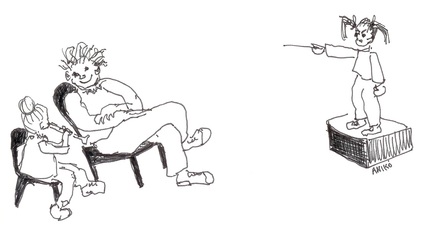Here's How to get us quiet
- Students talk to each other or goof off on their instruments when they're bored: when they're not focused on. A conductor can create focus through humor, respect, or fear. Just find a way that works for you.
- Whatever you do, don't let the students get bored! Sometimes explaining how important it is to you and why it's important to you to have an "ensemble culture" of quiet really works too. That way, you're allowing us to, in a way, get in your mind. We feel more connected to you because we know why and what you think about something important. Since it's important to you, it's important to us!
- Keep our focus and we'll stay quiet. Let it go for even a second and we'll get loud and it'll take several minutes to get it back.
- Part of getting an orchestra to be quiet is how much respect the orchestra has for you. Typically, the longer it takes for them to get quiet the less respect they have for you. With kids who respect you and want to play and learn, I think it is possibly to achieve an "ensemble culture" of quiet.
- I suggest having some sign that all the students will know and recognize. It should be something simple, but it needs to get their attention pretty easily. Flapping your arms like a chicken is excessive and silly. Something like raising your baton and waiting for everybody to be ready usually works decently enough.
- If we continue to play except to hear a brief comment from the conductor, we don't have much chance to get a conversation started, therefore we have no trouble ending one.
- Gaining your students' respect so all that is required for silence is a simple wave of baton.
From David:
Here's another way to quiet them down: bring chatty students up to the podium, sit where they sat and, well, behave like them.
Here's another way to quiet them down: bring chatty students up to the podium, sit where they sat and, well, behave like them.

- Young musicians often aren't aware of how strongly their behavior affects others.
- But when they see from the podium exactly how they look...the change can be miraculous - and you usually don't have to say a word! Just nod at them: "Do you see what I mean?" and they'll usually nod back.
- I take this approach regularly with Big Talkers...and it works almost every time (with gentle reminders, or course).
- The most memorable experience I've ever had in band was when the conductor (Mr. Barg), after trying and trying to get the ensemble quiet... got up and walked out of the room, leaving us and the other teacher in the room wondering what was up. Before he left, he told us to come get him when were ready to settle down and work.
was going on. We never did that before and it was scary, but neat. We decided we would
be quiet, and someone went out and got him. He came back and asked if we were ready to
be quiet and get to work. We were. Wow, did that ever work! The rest of the rehearsal was
great!
- Show us that you want everyone's attention. You do such a great job of this as well! :). Make it known that this is a team sport. A chain is as strong as its weakest link!
- If you hold up your baton as if cuing us up to play.
- We will follow the conductor. If the conductor becomes smaller but not hunched over because that will look silly, but just smaller will draw our attention in and make us quieter.
- Good classroom management - demands a clear start and end time, awareness of your audience (ie, the orchestra) and when they need relief and a break. And push hard in rehearsal.

